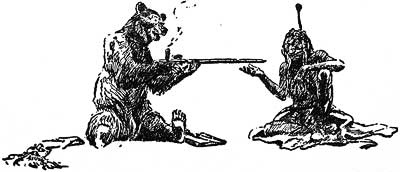Indian Why Stories
Sparks from War Eagle's Lodge-fire
by Frank B. Linderman

I dedicate this little book to my friend Charles M. Russell, the Cowboy Artist, George Bird Grinnell, the Indian's Friend, and to all others who have known and loved old montana.
Who have builded fires where nature
Wears no make-up on her skin.
Preface
THE great Northwest – that wonderful frontier that called to itself a world's hardiest spirits – is rapidly becoming a settled country; and before the light of civilizing influences, the blanket-Indian has trailed the buffalo over the divide that time has set between the pioneer and the crowd. With his passing we have lost much of the aboriginal folk-lore, rich in its fairy-like characters, and its relation to the lives of a most warlike people.There is a wide difference between folk-lore of the so-called Old World and that of America. Transmitted orally through countless generations, the folk-stories of our ancestors show many evidences of distortion and of change in material particulars; but the Indian seems to have been too fond of nature and too proud of tradition to have forgotten or changed the teachings of his forefathers. Childlike in simplicity, beginning with creation itself, and reaching to the whys and wherefores of nature's moods and eccentricities, these tales impress me as being well worth saving.
The Indian has always been a lover of nature and a close observer of her many moods. The habits of the birds and animals, the voices of the winds and waters, the flickering of the shadows, and the mystic radiance of the moonlight – all appealed to him. Gradually, he for- mulated within himself fanciful reasons for the myriad manifestations of the Mighty Mother and her many children; and a poet by instinct, he framed odd stories with which to convey his explanations to others. And these stories were handed down from father to son, with little variation, through countless generations, until the white man slaughtered the buffalo, took to himself the open country, and left the red man little better than a beggar. But the tribal story-teller has passed, and only here and there is to be found a patriarch who loves the legends of other days.
OLD-man, or Napa, as he is called by the tribes of Blackfeet, is the strangest character in Indian folk-lore. Sometimes he appears as a god or creator, and again as a fool, a thief, or a clown. But to the Indian, Napa is not the Deity; he occupies a somewhat subordinate position, possessing many attributes which have sometimes caused him to be confounded with Manitou, himself. In all of this there is a curious echo of the teachings of the ancient Aryans, whose belief it was that this earth was not the direct handiwork of the Almighty, but of a mere member of a hierarchy of subordinate gods. The Indian possesses the highest veneration for the Great God, who has become familiar to the readers of Indian literature as Manitou. No idle tales are told of Him, nor would any Indian mention Him irreverently. But with Napa it is entirely different; he appears entitled to no reverence; he is a strange mixture of the fallible human and the powerful under-god. He made many mistakes; was seldom to be trusted; and his works and pranks run from the sublime to the ridiculous. In fact, there are many stories in which Napa figures that will not bear telling at all.
I propose to tell what I know of these legends, keeping as near as possible to the Indian's style of story-telling, and using only tales told me by the older men of the Blackfeet, Chippewa, and Cree tribes.